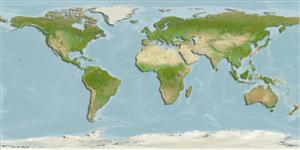Élasmobranches (requins et raies) (sharks and rays) >
Carcharhiniformes (Ground sharks) >
Scyliorhinidae (Cat sharks) > Scyliorhininae
Etymology: Cephaloscyllium: cephalus, from kephale (Gr.), head, referring to its very broad and depressed head; skylion, Greek for dogfish or small shark (See ETYFish); stevensi: In honor of John Stevens (b. 1947), whose 1994 work (with Peter Last) on Australian sharks was the “foundation for research that led to the descriptions of 37 new chondrichthyan fishes, including 11 species of Cephaloscyllium” (See ETYFish).
Eponymy: Dr John Donald Stevens (d: 1947) is a biologist and ichthyologist who was a Senior Principal Research Scientist with CSIRO Marine and Atmospheric Research, originally in Sydney (1979–1984) and subsequently in Hobart, Tasmania, Australia (1984–2011). [...] (Ref. 128868), visit book page.
More on authors: Clark & Randall.
Environment: milieu / climate zone / depth range / distribution range
Écologie
marin; profondeur 240 - 274 m (Ref. 86282). Tropical
Western Pacific: Papua New Guinea.
Taille / Poids / Âge
Maturity: Lm ? range ? - ? cm
Max length : 66.0 cm TL (female)
Description synthétique
Clés d'identification | Morphologie | Morphométrie
Similar to its congeners, this species is most easily distinguished by its color pattern: gray-brown above, whitish ventrally, mottled with brown and whitish spots of variable size over head and body, including ventrally; 6 large dark brown saddle blotches dorsally on head and body and 3 on caudal fin; first four dorsal dark blotches connecting or leading obliquely to other dark blotches below; small white spots most distinct within or at edges of dark brown blotches (Ref. 86282).
Life cycle and mating behavior
Maturité | Reproduction | Frai | Œufs | Fécondité | Larves
Clark, E. and J.E. Randall, 2011. Cephaloscyllium stevensi: a new species of swellshark (Carcharhiniformes: Scyliorhinidae) from Papua New Guinea. aqua, Int. J. Ichthyol. 17(1):23-34. (Ref. 86282)
Statut dans la liste rouge de l'IUCN (Ref. 130435: Version 2024-1)
Menace pour l'homme
Harmless
Utilisations par l'homme
Outils
Articles particuliers
Télécharger en XML
Sources Internet
Estimates based on models
Preferred temperature (Ref.
123201): 8.9 - 11.8, mean 9.1 °C (based on 6 cells).
Phylogenetic diversity index (Ref.
82804): PD
50 = 0.5000 [Uniqueness, from 0.5 = low to 2.0 = high].
Bayesian length-weight: a=0.00263 (0.00138 - 0.00502), b=3.21 (3.04 - 3.38), in cm total length, based on LWR estimates for this (Sub)family-body shape (Ref.
93245).
Niveau trophique (Ref.
69278): 4.1 ±0.5 se; based on size and trophs of closest relatives
Résilience (Ref.
120179): Faible, temps minimum de doublement de population : 4,5 à 14 années (Preliminary low fecundity).
Fishing Vulnerability (Ref.
59153): Moderate to high vulnerability (46 of 100).
